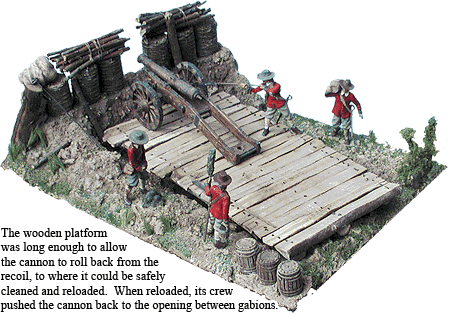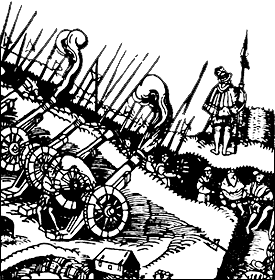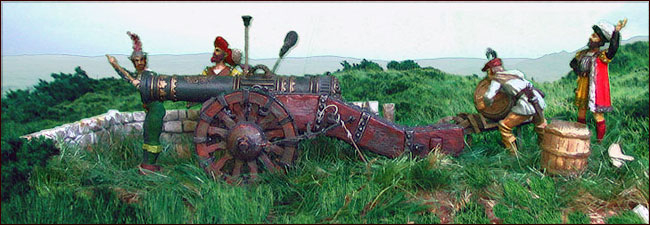 |
Cannon vs. Cannon |
 While
investing a fortification started the siege, it served only to
entrap and hold; artillery was necessary to reduce the defender's
ability to fight and to break down the defenses. Bringing
artillery quickly to the siege was paramount. The Spanish
suffered delays when bringing their artillery to the Alkmaar when
they began the siege in 1574. About 20 days following the
investment, the cannons finally began
firing, but the season was late, rains had begun, winter was coming,
and so the Spanish decided to abort the siege.
While
investing a fortification started the siege, it served only to
entrap and hold; artillery was necessary to reduce the defender's
ability to fight and to break down the defenses. Bringing
artillery quickly to the siege was paramount. The Spanish
suffered delays when bringing their artillery to the Alkmaar when
they began the siege in 1574. About 20 days following the
investment, the cannons finally began
firing, but the season was late, rains had begun, winter was coming,
and so the Spanish decided to abort the siege.
Attackers assembled their cannon in batteries nestled behind gabions and heaped-up earth to create in effect little fortifications. These redoubts could have trenches in front or all around in which infantry huddled, ready to defend their cannon against probes from the fort. Trenching connected one battery to another and all the way back to the countervallation (ammunition had to have been replenished, after all).

Note the infantry
huddled in the trench in front. One has to wonder about incidences of tinnitus and ruptured eardrums among such men.
There were situations in which the attackers needed a heightened vantage point for their artillery. They heaped up earth, logs and rocks to make a raised area and then set gabions, fascines and earthen walls around it. Elevated cannon redoubts were termed "cavaliers."
An artillery piece stationed behind a wall of gabions sat on its own wooden platform that kept it off the ground, which could be mud or, even if dry, eroded away underneath the cannon by the recoil as it fired - and fired - and fired.
Once set up, the first objective of the besieger's artillery was to knock out the cannons of the besieged. Although comparable in caliber, the besiegers' cannon usually dominated the exchange of fire by simply outnumbering their counterparts in the fort.
Although gun crews aimed at the embrasures of the fort, considering the distances and that the attackers' artillery skills were likely on par with those inside the fort, streams of cannonballs were required. Through sheer volume of fire, one by one the defender's cannon were hit and knocked out. Not surprising, some besieger's batteries were also hit from long shots taken by defenders. What gave the attackers the advantage in this situation was their cannon outnumbered those of the defenders on that side of the fort.
Once the attackers brought up artillery and placed it, terms of surrender became more strict. The amount of effort and time expended by the besiegers to reach this stage sucked away much of their generosity. A sack became a distinct possibility. After the attackers began the bombardment, a sack became a probability.
Curiously, in the first decades of the 16th century, sometimes the opening shots from the besiegers' artillery unleashed those inside to throw aside common sense and eat, drink, make merry, and pillage. This attitude quickly cleaned out provisions to render the defenders amenable to quick surrender.
When sappers had dug trenches closer to the fort plus some or most of the fort's cannon had been silenced, besiegers could move their artillery nearer to the target. With that, bombardment became more accurate.
Already having suffered a loss in fighting power (and having been introduced to what more was to come), at this point the besieged could have had second thoughts about the wisdom of continuing to resist. Robert Monro mentioned the surrender of Mainz: "Our Cannon having from the Hessen side so spoyled the Burgers on the streets, and within their houses, finding their owne hurt, being stronger than the Garrison, forced the Garrison to Accord, by that meanes preventing their owne ruine, and the losse of their goods, if the Towne had beene taken by storme. And therefore, for sparing of their Citie, they promised his Majestie (King Gustavus Adolphus), for keeping good order, threescore thousand Dollars (Thalers)."

| Back |
Advanced Batteries |
|
|
|